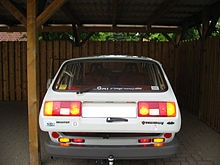Taillight





Taillights are the part of the vehicle lighting that can be found on the rear border contour of a vehicle and that are directed towards the rear.
From a bicycle taillight to multifunctional light units on cars, vans and trucks, taillights are very diverse.
Taillights are traditionally found as lighting units, which usually combine several functions in one plastic unit, which are implemented using individual light bulbs in different lamp bases .
In earlier decades, the replacement of defective taillights was often made possible by removing the composite plastic disc on knurled screws . Since the 1980s, taillights have increasingly been built so that a light bulb can be changed from inside the vehicle without tools.
Functions in motor vehicles are:
- Tail light, (colloquially taillight ) (red, 5 or 10 watts continuously lit; together with the front marker lights also called parking lights )
- Brake lights (red, 21 W)
- Direction indicator , (colloquially blinker) (orange, 21 W, also permitted in red until the end of 1969, often implemented with white cover glass and orange light bulb since the 1990s)
- Reversing light (white, 21 or (less often) 16 W)
- Rear fog lights (red, 21 W or 19 or 24 W with HP bulbs), 36 W on some classic cars,
- Side marker lights (yellow or red, 3, 5 or 10 W, together with the tail light)
- partly license plate lights (white, 5 W)
The light intensities (in candela ) from different viewing angles are specified by law (e.g. in the ECE or SAE standard).
WY21W lamp 21 W yellow
for signal (turn signal, brake light), also with pulse width modulation as tail light in the brake light
While light-emitting diodes were used as a third brake light above or behind the rear window as early as the mid-1990s , it was not until the early 2000s that LEDs were used in the rear light for the first time. The advantages of LED lights are a very long service life, which is theoretically the life of the vehicle, and the significantly lower energy consumption. The use of LEDs is problematic when several functions (mostly rear and brake lights) are implemented with the same light source and a slow pulse width modulation - which is unproblematic in the incandescent lamp version - is used to generate the required different brightnesses. While incandescent lamps emit practically continuous light due to the inertia of the filament, LEDs only light up during the switch-on phase. With rapid eye movements ( microsaccades ), this leads to the rear lights being displayed next to each other on the retina and no longer always perceived as an object ( pearl effect ). The perception of this effect and the associated distraction from the traffic situation differs from person to person (similar to the rainbow effect ). The problem could easily be solved by using higher pulse frequencies, which, however, entails more complex (= more expensive) EMC measures. This effect is intensified when the individual LEDs have high and uneven luminance levels .
Taillights are purchased parts. Manufacturers of such units are mainly companies such as
- Hella , Odelo, Automotive Lighting , Jokon, Gebra and GEKA from Germany,
- Magneti Marelli from Italy,
- Valeo from France,
- Koito and Ichikoh from Japan,
- TRW Automotive and Visteon from the USA,
- Lucas from the UK as well
- TYC from Taiwan
The automobile manufacturers work together with the suppliers to develop a functional lamp that meets the legal requirements and is adapted to the vehicle manufacturer's design requirements.
literature
- Hans-Hermann Braess, Ulrich Seiffert: Vieweg Handbook Motor Vehicle Technology , 6th edition, Verlag Vieweg + Teubner Wiesbaden 2011, ISBN 978-3-8348-1011-3
- Jürgen Kasedorf, Richard Koch: Service primer for vehicle electrics , 15th edition, Vogel Buchverlag, 2007, ISBN 978-3-8343-3098-7
Individual evidence
- ↑ Disco lightning on the Autobahn , stern.de, July 18, 2008





